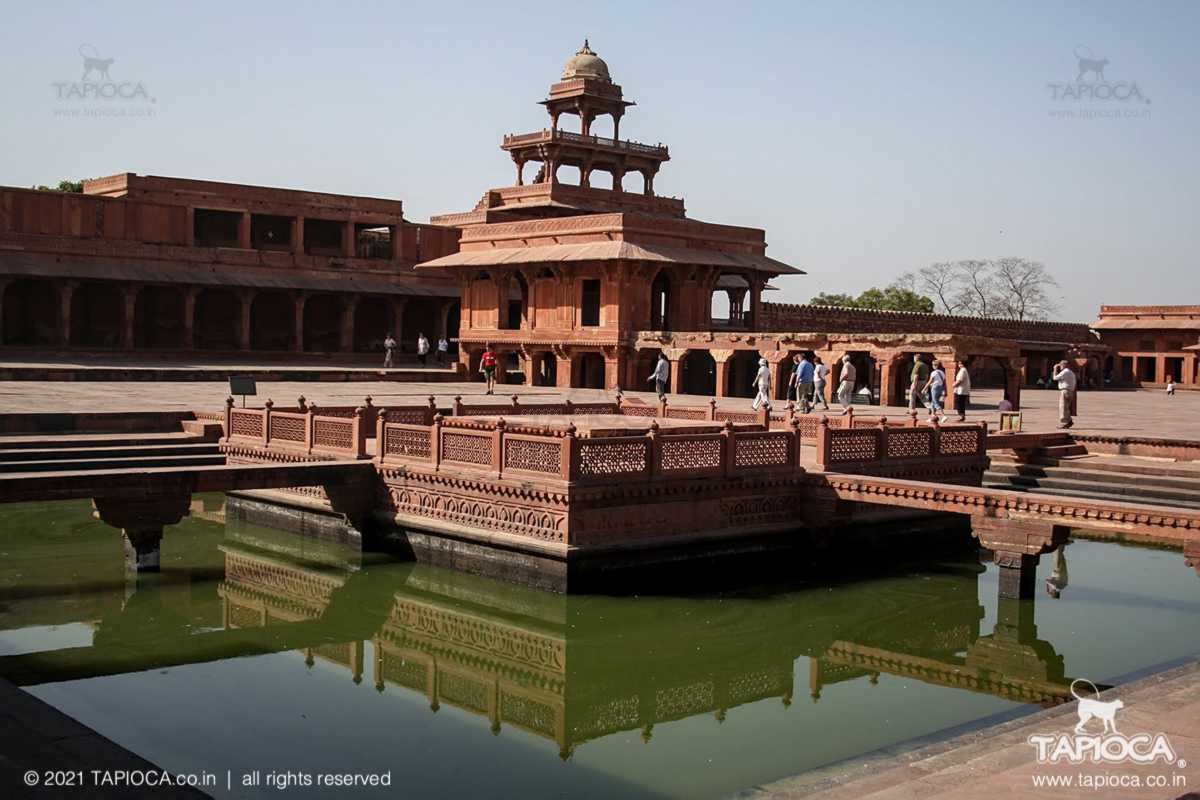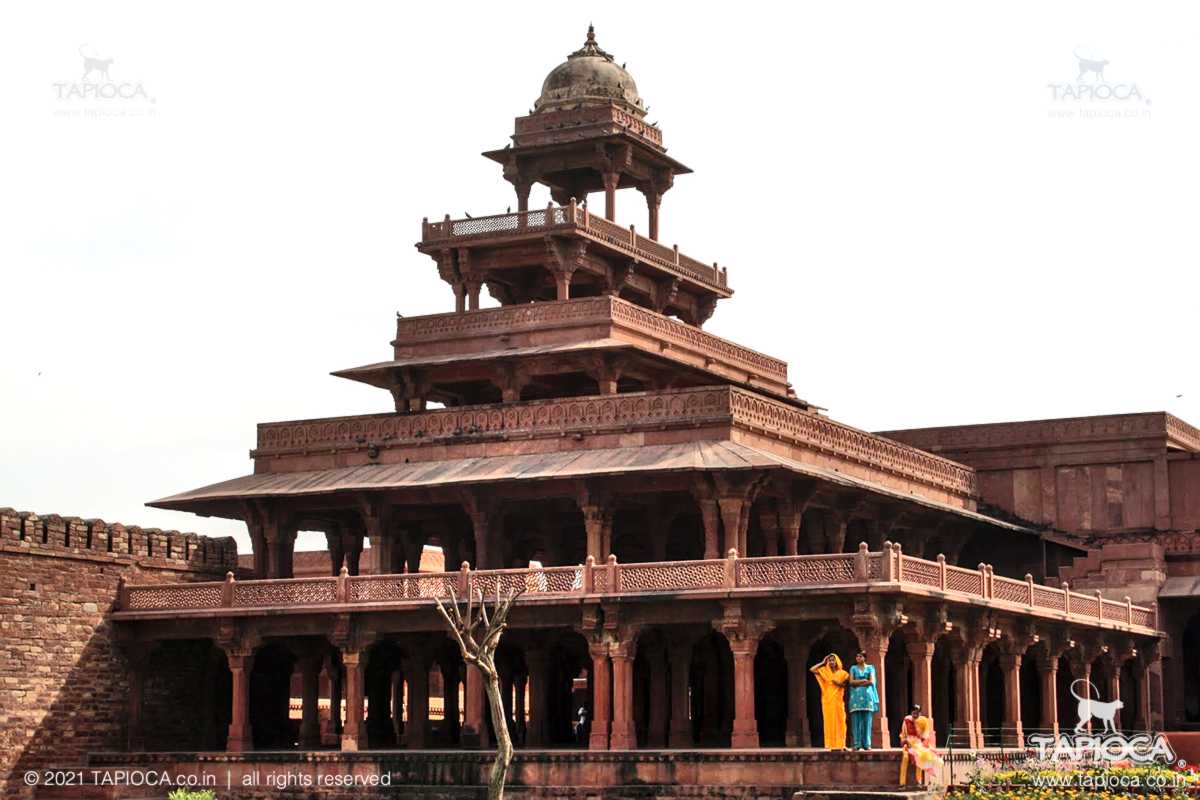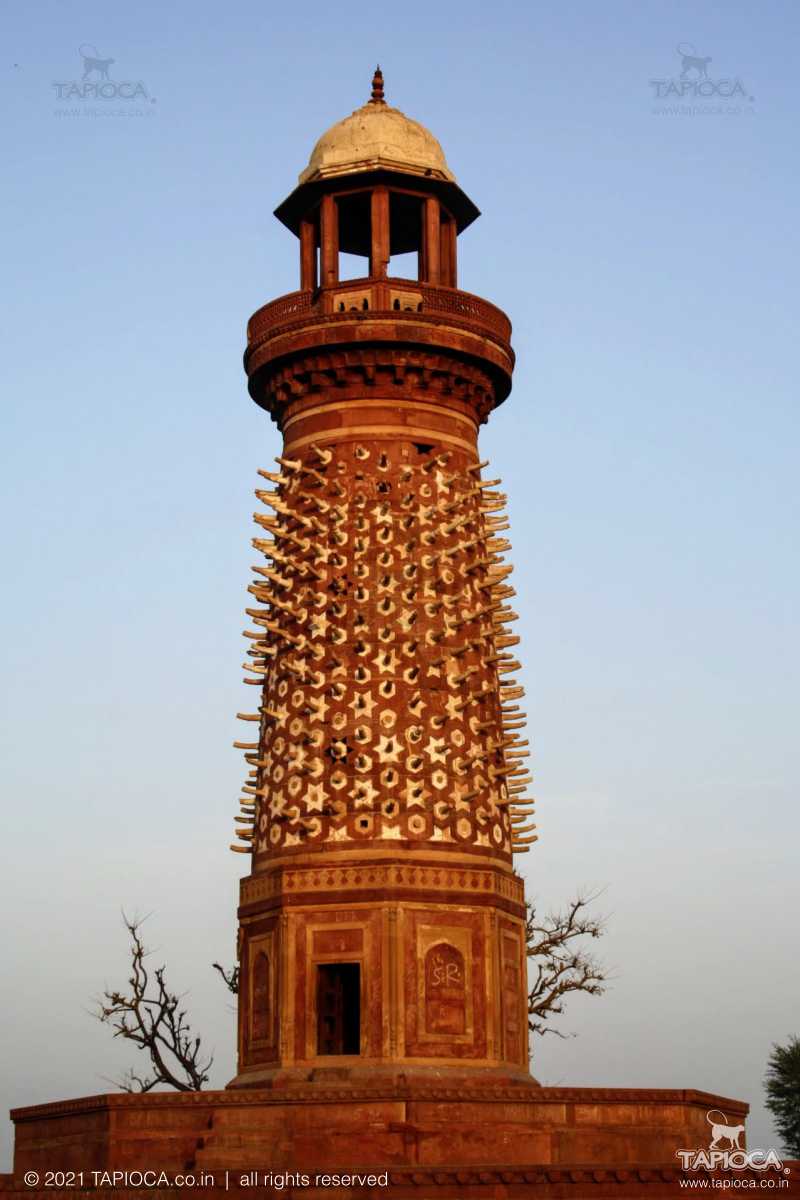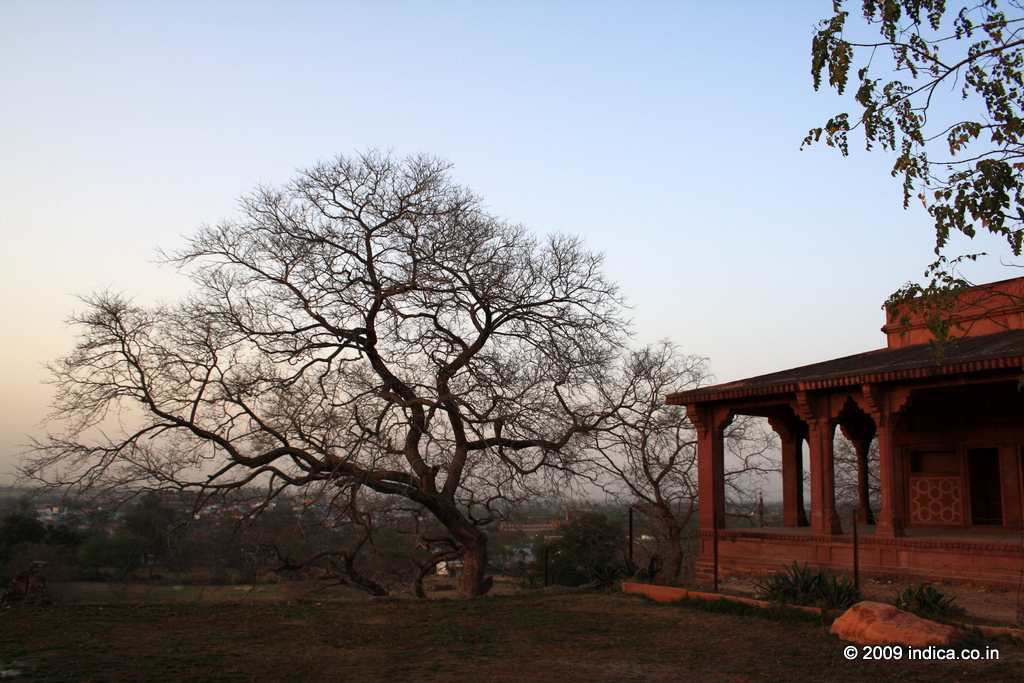Fatehpur Sikri
Fatehpur Sikri was the capital of Mughal India for a short period. It's spectacular, at the same time carries an eerie look!

Fatehpur Sikri
Anup Talao, a centerpiece in Fatehpur Sikri's attractions. In the backdrop is the 5 storied Panch Mahal
D
uring the days of Akbar, the most prominent of the Mughal emperors, Fatehpur Sikri was the capital of Mughal India.Fatehpur Sikri is located in Uttar Pradesh , about 40km ( 25 miles) west of Agra , the city famous for the Taj Mahal.
Though very unlikely, the most popular reason told for this is some kind of water shortage or drought in the capital region.
Fatehpur Sikri is now a ghost city, popular among both tourists and archeologists. What you can see is magnificent ruins of the bygone era, some are in excellent state pf preservation, and some are literally covered by shrubs and bushes.
Some of the popular monuments in Fatehpur Sikri :
Naubat Khana (The Drum House) : Near the entry point to the city. The road passes through this building. Probably this was the place that announced the arrival of the emperor.
Diwan-i-Am ( Hall of Public Audience ) : The place where the ruler meets the general public. Diwan-i-Am is a typical feature of all the Mughal palaces. At one end of the court is an elevated pavilion. The pierced stone screens are most noteworthy. Now the open court is converted into a garden with lawn, where once stood the courtiers in humility.
Diwan-i-Khas ( Hall of Private Audience ) : This is where Akbar met his ministers, scholars and generals to discuss religious and courtly matters. The central bracket is one of its kinds.
Char Chaman Tank : Anup Talao, with is central island like platform
Birbal House: Though it is named so, chances are unlikely that this was used by this famous minister of Akbar. This is one of the most beautiful buildings within the palace complex.
Mariam-uz-Zamani's Palace: It is believed that this building within a large court was used by Akbar’s queen Mariam Zamani. It’s built in Hindu style with many themes taken from the Hindu mythology painted on the walls.
Pachisi Court This is located at the very center of the main palace complex. On the open floor are the markings of a board game called Pachisi , hence the name.
Char Chaman Tank : An ornate tank in the central court of the palace. Four bridges connects to the central platform.
Panch Mahal: A progressively diminishing 5 storied open structure. A five storied palatial structure.
Jama Masjid: The Cathedral Mosque of Fatehpur Sikri. A large mosque built by Akbar. The domed pavilions around the court are unique. The mosque is located at the highest point in Fatehpur Sikri.
Tomb of Salim Chisti: This white marble shrine houses the tomb of Salim Chisti, a saint and spiritual master of Akbar. In fact Akbar built the capital at Fatehpur Sikri in respect of Salim Chisti.
Buland Darwaza (the Gate of Magnificence) : A huge gateway to the Jama Masjid.
The Turkish Sultana's House : The most elaborately carved building in Fatehpur Sikri. It’s often attributed to the Turkish wife of Akbar.
The Yogi's Seat: A small but splendid pavilion that houses a seat.
The Hospital: A hospital with wards built inside the palace compound. There’s even the trace of a chapel.
Agra Gate: One of the gateways to the walled city. The gate faces towards the direction of Agra, hence the name.
The Mint: The imperial mint and the treasury buildings are located nearby.
Daftar Khana (Record Chamber) : This was the place where the imperial records where kept . Also this was used as the office of Akbar. It’s now concerted as a traveler’s bungalow.
Kwâbgâh : Sleeping apartment of Akbar. This is a small pavilion on the roof Diwan Khana-i-Khas, where he met his close confides.
Hakim Baths (Doctor’s Bath) : Theses were the baths used by Akbar . The presence of the Hakim's quarters nearby earned it the name.
Ankh Michouli ( Blind-man's Buff House) : Thanks to the way it is constructed , people often attribute this building the game of hide and seek. And even extended that to the level that Akbar played the hide and seek game with the women of the harem! Most likely this is the vault house of the palace where valuables were kept in the safe custody.
Jodha Bai Palace : This is a large harem were the women of the palace lived.
Hathi Pol ( Elephant Gate) : Two giant images of elephants are carved on either sides of this gate to the citadel.
The Stone-Cutters' Mosque : This mosque was erected in the name of Fatehpur’s quarrymen.
The Houses of Abul Fazl and Faizi : These houses where of the two scholar brothers of Akbar’s court. It’s located behind the main mosque of Fatehpur Sikri.
Tansen Baradari : Often attributed as the residence of Tansen, the legendary musician of Akbar’s court. It is a well preserved beautiful pavilion located between Naubat Khana and Agra Gate. This smartly proportioned pavilion consists of sandstone built verandah around a central room.
Hauz-i-Shirin (Sweetwater tank) : A tank located behind the Mint to collect rainwater. In all probability this was used for the imperial kitchen.
Hakim’s Quarters : The residence of the Hakim brothers, who where nobles in Akbar’s court.
Shah Quili’s Baoli : The construction of this stepped well is attributed to Shah Quili Khan. He was one of Akbar’s Governors. This well is located at the south of the ruins close to the village square. The water from here was lifted to the hydraulics system that was connected to the baths within the court premises.
Caravanserai : This large guesthouse complex of the palace is located between the northern slop of the ridge and the Hiran Minar. During the Mughal days this served as the rest house for important guests and traders who visited the capital. Caravanserai is a series of vaulted rooms around a sprawling square open courtyard.
Samosa Mahal : This building with its triangular courtyard and colonnade is located behind the Jama Masjid complex on the slop of the ridge. The original intent of this building is not known. However the peculiar shape – that of the Indian pastry called Samosa – earned it the name.
Ticket Counter near Jodh Bhai’s Palace. The Second ticket counter is located outside the Diwan-i-Am area whn you access it via Naubat Khana.
Badshahi Darwaza (King’s Gateway): This majestic gateway projects on the eastern wall of the Jami Masjid complex. Though it is not as imposing as the Buland Darwaza, in magnificence Badshahi Darwaza is no less attractive. This gateway was used by Akbar to attend the congregation in the Jami Masjid , hence the name.
Diving Well : This giant octagonal well is located right next to the Buland Darwaza of Jami Masjid. Currently houses of Fatehpur Sikri villages are located around this well.
Langar Khana ( Open Court) : This is located outside the southeast of Jama Masjid. This open court with cloister around was used as a kitchen to feed poor.
Hiran Minar : This curiously shaped tower stands on the edges of the ruins now facing the wheat fields. The original intent of this tower is still being debated. The whole tower is decorated with
Anup Talao : Or ‘Peerless Pool’, is located in the central open courtyard of the palatial complex. During the warm periods of the year, the pool is dry. A central rectangular platform projects in the center of the stepped pool. On the four sides of the poor are four fridges that give access to the central platform. Balustrades with lattice is interesting.
The Camel Stable: Note the row of hooks used to tie camels. According to some account, this was not used as a camel stable. Instead this pavilion was the quarters of the servant maids if the Harem. The hooks were used to anchor the partition curtain.
Nangina Masjid : The private mosque for the ladies of the Harem.Located between the Elephant Gate and Birbal’s Palace.
Adbar Khana : This pavilion located close to Anup Talao. It’s popularly believed that this is where fruits and drinking water for Akbar was kept by the trusted aides. This two storied pavilion, overlooking the open court and the Anup Talao is often (wrongly) referred as Girl’s School.
Din-i Ilahi is a religion associated with Akbar, rather created by him. It is the culmination of his religious thoughts and the insights generated out the courtly debate and discussions he conducted among the religious scholars.
Din-i Ilahi is essentially a conglomeration of ideals picked from Islam, Hinduism, Christianity, Jainism and Zoroastrianism, notably from Islam and Hinduism.
The Ibadat Khana in Fatehpur Sikri is often attributed as a venue where Akbar conducted such regular philosophical interactions. Akbar's conclusion was no single religion could claim as the sole domain of truth. Nor no single religion is perfect over the other.
Surprisingly enough there were no notable subscription to his ideology. Though a powerful emperor , we was often blamed for blasphemy by the then clergy. Only Akbar himself and his faithful minister were the notables ascribed to Din-i Ilahi.
Even his commander in chief refused to convert to Din-i Ilahi. Known for his ideological tolerance , it is not surprising that people to ascribe to their faith fearlessly.
Din-i Ilahi essentially is a combination of mysticism, philosophy and nature worship ( especially sun worship ).
Agra Gate : One of the main gateways to the walled city
Access :
Fatehpur Sikri is well connected by road. Agra is the nearest major town with bus, Rail and air connectivity. From Agra Idga bus station frequent bus services are available for Fatehpur Sikri. Travel time is typically less than an hour. Most of the buses going towards Jaipur and Bharatpur drops you at the bypass junction. The ruins and Fatehpur Sikri proper are about 10 minutes walk from here.
Get to this point to catch one of those bus for return journey, though there is a tiny bus station located right next to the village square.
Fatehpur Sikri has a small railway station. You can catch one of those trains from Agra Fort station that goes via Fatehpur Sikri.
Another route is through Bharatpur, the town in Rajastan famous for the UNESCO World Heritage Site bird sanctuary.
Bharatpur has a major railway station.
Accommodation : There are a handful of guesthouses and lodges in Fatehpur Sikri aimed at the budget travelers. Most of them are located near the ruins and around the village.
Guides : It seems anyone and everyone in this neighborhood has the agility to metamoprph into a guide. Qualified guides are available near the ticket counter. Try to avoid the unauthorized 'guides' who pester the visitors the moment one gets down from the bus. These tout-cum-guides are highly active around the Jami Masjid area and the road leading to it.
If you are so needed a guide, fix up the rate & itinerary up front. Also make it clear that you need only guide service to the monuments and nothing else ( like hotel booking, souvenir shopping , donation for a charity and so on... ).
The qualified guides don't move around like a tout, nor they are pushy.
Typically they approach as you buy ticket and enter the monument. Hire a guide for an hour or so in the palace complex for a quick tour. Pay and release the guide after a tour. Now you can spend your time re visiting the spots again at your leisure. That is the best strategy especially if you wants to relax and see things at your own pace.
By the way it is worth hiring a guide. More so if you are new to the whole gamut of Mugal history and architecture.

Fatehpur Sikri
Note the Buddhist architectural influence in its design

Fatehpur Sikri
The curiously shaped Hiran Minar in the middle of a wheat field

The evening light cast a warm glow on the reddish sandstone structures of Fatehpursikri.
The evening light cast a warm glow on the reddish sandstone structures of Fatehpursikri.
